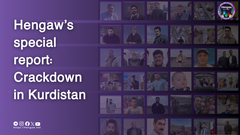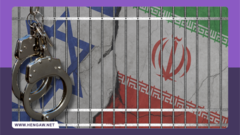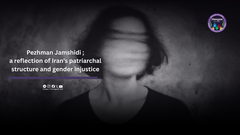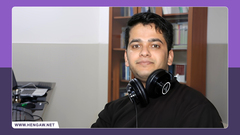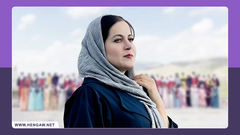Hengaw special report on the 12-day war between Iran and Israel—casualties and human rights violations one month after the ceasefire
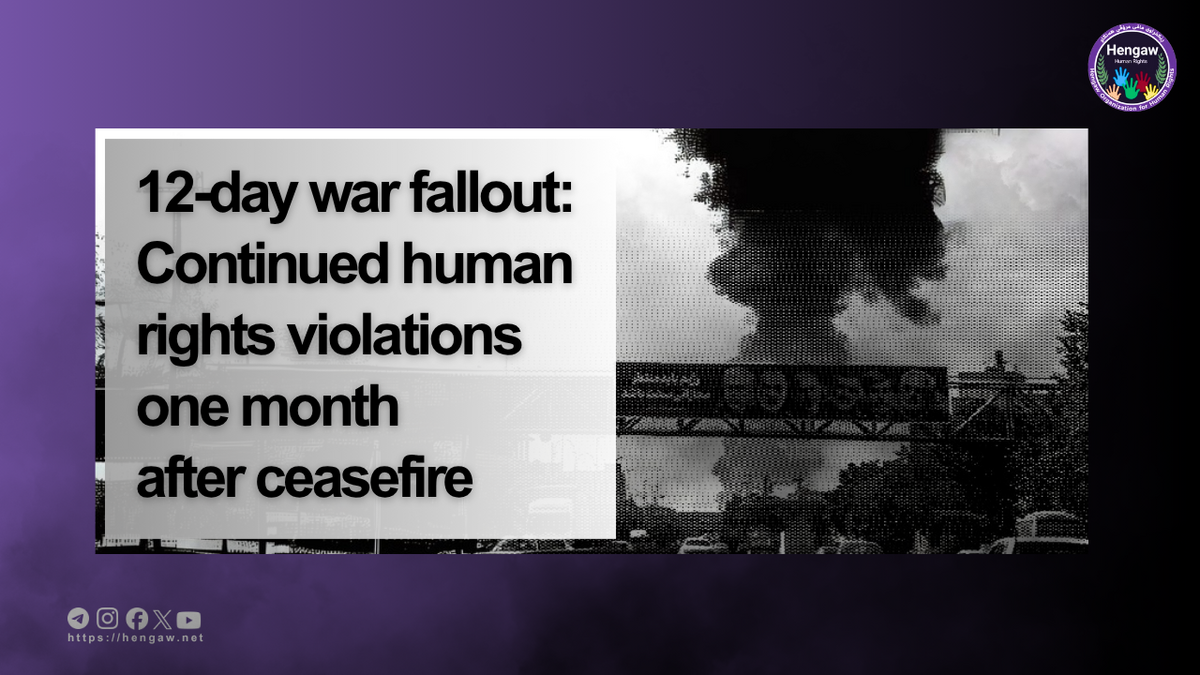
Following direct military confrontations between the Islamic Republic of Iran and the State of Israel, which began in the early hours of Friday, June 13, 2025, and lasted for 12 days, the Hengaw Organization for Human Rights has utilized its field network across Iran and consulted credible sources to collect, verify, and document the human impact of the war.
According to the data obtained, at least 1,082 individuals were killed in Iran during the 12-day war. This includes 182 civilians and 900 members of the military, security forces, and technical personnel affiliated with the Islamic Republic’s military institutions.
Among the civilian casualties, at least 68 women and 45 children were identified. In addition to documenting these deaths, the present report addresses mass arrests, the issuance of death sentences, attacks on prison facilities, and the intensification of pressure on vulnerable groups—including kolbars (cross-border porters) and ethnic minorities.
This report is the fourth analytical and statistical publication by Hengaw on the war’s developments and the human rights situation in Iran since the beginning of the hostilities.
This report includes the following 11 sections and subsections:
1. Killing of 182 civilians during the 12-day Iran–Israel war
2. Killing of at least 45 children and adolescents under the age of 18
3. Killing of 68 women, including two members of security forces
4. Evin prison and human losses during the 12-day Iran–Israel war
5. Killing of 900 military personnel across Iran
6. Human rights violations in Iran one month after the ceasefire:
A) Prison conditions and the deaths of two Kurdish political prisoners
B) Increased pressure on kolbars—killing of seven young kolbars
C) Killing of ordinary civilians during checkpoints and raids
D) Heavy sentences, including 18 death sentences for 9 political prisoners
E) Increase in executions—execution of six prisoners on charges of spying for Israel
F) Arrest of over 1,800 civilians
Killing of 182 civilians during the 12-day Iran–Israel war
During the first 12 days of the conflict, at least 182 civilians were killed in missile and aerial attacks. Hengaw has so far verified the identities of 180 of these individuals.
Among the victims were:
64 women
45 children and adolescents under the age of 18
1 Afghan national
In several cases—including the deaths of two children in Tabriz, a child in Marivan, and a man in Andimeshk—the cause of death was attributed to shrapnel from Islamic Revolutionary Guard Corps (IRGC) air defence systems operating in residential areas.
Hengaw’s findings also indicate that 48 civilian victims were immediate relatives of IRGC personnel.
Provincial breakdown of civilian casualties:
Tehran Province: 132 cases
Gilan Province: 15 cases
Isfahan Province: 10 cases
Hamadan Province: 9 cases
Kermanshah (Kermashan) Province: 5 cases
Khuzestan Province: 4 cases
Qom Province: 4 cases
East Azerbaijan Province: 4 cases
Lorestan Province: 2 cases
Alborz Province: 2 cases
Kurdistan Province (Sanandaj): 1 case
Killing of at least 45 children and adolescents under the age of 18
Hengaw confirms that at least 45 children and adolescents under the age of 18 were killed during the Israeli attacks. Among the victims were 22 girls and 23 boys. Two of the children were just 2 months and 7 months old, while the oldest was 17 years of age.
In Tehran Province, 25 children lost their lives—accounting for 55% of all recorded cases. Additionally, three children were killed by direct impact from shrapnel caused by Iranian air defence systems.
Names and ages of the children and adolescents killed, by province:
Tehran Province (25 cases):
Amir Ali Amini, 12-years-old
Parham Abbasi, 15-years-old
Rayan Ghasemian, 2 months
Zahra Zakerian Amiri, 7 months
Fatemeh Zakerian Amiri, 7-years-old
Baran Eshraghi, 9-years-old
Mahya Nikzad, 7-years-old
Motahareh Niyazmand, 6-years-old
Ali Niyazmand, 10-years-old
Fatemeh Niyazmand, 12-years-old
Soheil Katouli, 11-years-old
Mohammad Reza Sedighi Saber, 17-years-old
Matin Safaeyan, 16-years-old
Zahra Barzegar, 3-years-old
Tara Hajimiri, 8-years-old
Mohaddeseh Aghdasi, 13-years-old
Mohammad Reza Aghdasi, 10-years-old
Kian Ghasemian, 5-years-old
Sarvin Hamidian, 8-years-old
Mersana Bahrami, 8-years-old
Mehrdad Kheiri, 5-years-old
Amir Abbas Jafarabadi, 9-years-old
Mohammad Ali Bahmanabadi, 1-years-old
Zahra Bahmanabadi, 7-years-old
Hanieh Bahmanabadi, 4-years-old
Isfahan Province (7 cases):
Aima Zeinali, 7-years-old
Heida Zeinali, 4-years-old
Seyed Ali Sadat Aramaki, 6-years-old
Reyhaneh Sadat Aramaki, 15-years-old
Fatemeh Sharifi, 11-years-old
Mojtaba Sharifi, 8-years-old
Fatemeh Sadat Aramaki, 8-years-old
Gilan Province (5 cases):
Seyyedeh Mahya Sedighi Saber, 8-years-old
Milan Saber, 6-years-old
Yas Saber, 14-years-old
Amir Ali Chatranbarin, 13-years-old
Hamid Reza Sedighi Saber, 17-years-old
Qom Province (2 cases):
Ehsan Ghasemi, 16-years-old
Mohammad Hossein Khaki, 15-years-old
East Azerbaijan Province (2 cases):
Taha Behroozi, 8-years-old
Elisa Jabari, 8-years-old
(Both were killed by Iranian air defence systems)
Khuzestan Province (1 case):
Armin Mousavi, 7-years-old
Kermanshah (Kermashan) Province (1 case):
Yasin Molaei, 6-years-old
Lorestan Province (1 case):
Helena Gholami, 11-years-old
Kurdistan Province (Sanandaj): 1 case
Sajjad Sarmadi, 9-months-old (killed by Iranian air defence)
Killing of 68 women, including two members of security forces
As of this report, Hengaw has confirmed the identities of 68 women killed during the conflict, of whom 56 were in Tehran Province.
Beyond Tehran, the highest numbers were recorded in:
Gilan Province: 5 cases
Isfahan Province: 2 cases
Kermanshah, Qom, Alborz, and Khuzestan Provinces: 1 case each
According to these figures, at least five women killed were members of the Islamic Revolutionary Guard Corps (IRGC), Law Enforcement Force, or other security agencies.
Evin prison and human losses during the 12-day Iran–Israel war
During the recent 12-day war between Iran and Israel, Tehran’s Evin Prison became a central site of human losses, raising serious human rights concerns.
As of July 21, 2025, Hengaw has independently confirmed the deaths of 44 individuals at Evin Prison, including: 16 military and law enforcement personnel (soldiers and officers), and 28 civilian staff and administrative employees. Among the civilian victims were 10 women and 1 child.
While official Iranian sources and some international media have reported between 71 and 80 deaths, Hengaw has so far verified only 44 based on independent documentation.
According to Hengaw’s investigation, the June 23, 2025 attack on Evin primarily targeted civilian sections of the prison. Severe destruction of the visitation hall, administrative offices, and clinic caused many civilian casualties, including service workers, healthcare personnel, ordinary prisoners, and families visiting inmates.
Hengaw’s sources emphasize that the explosions occurred during peak hours when the administrative buildings and clinic were crowded. The clinic’s roof and the visitation hall’s walls completely collapsed. Images from the site show bodies left unattended, delayed rescue efforts, and an intense security presence.
Hengaw expresses deep concern for the safety of other prisoners, especially political and ideological detainees. While the attack was carried out by Israel, under international humanitarian law, the Islamic Republic of Iran, as the detaining authority, is responsible for protecting the lives of detainees and civilian staff even in wartime.
Failures including lack of timely evacuation, insufficient protective measures, and continuation of in-person visits during high-risk hours constitute structural negligence. The deaths of women, children, and civilians under these conditions represent a clear violation of international obligations and underscore the urgent need for independent investigations and accountability.
Killing of 900 military personnel across Iran
From the early hours of Friday, June 13, 2025, with the onset of direct air and missile strikes by Israeli forces against IRGC and other military-security positions across Iran, the number of military fatalities increased sharply.
Field data and documentation collected by Hengaw indicate that during the 12-day conflict, at least 900 military personnel were killed, including members of the army, IRGC, law enforcement, Basij, nuclear scientists, technical elites, and staff of security-affiliated institutions. Hengaw has fully identified 570 of these individuals. The highest number of military fatalities has been reported in the provinces of Tehran, Kermanshah (Kermashan), East Azerbaijan, Lorestan, Alborz, Qom, and Isfahan.
Breakdown of military fatalities by province:
Tehran province: 295 cases
Kermanshah (Kermashan) province: 100 cases
East Azerbaijan province: 98 cases
Qom province: 74 cases
Isfahan province: 75 cases
Lorestan province: 75 cases
Alborz province: 35 cases
Khuzestan province: 30 cases
West Azerbaijan province: 30 cases
Zanjan province: 20 cases
Hamadan province: 20 cases
Markazi (Central) province: 17 cases
Yazd province: 15 cases
Fars province: 7 cases
Kurdistan (Sanandaj) province: 9 cases
In Tehran Province, the main target of Israeli strikes, at least 295 military personnel were killed. Hengaw has verified the full identities of 196, including 11 senior IRGC commanders, 14 nuclear scientists, and 2 regime-affiliated elites linked to the IRGC.
Human rights violations in Iran one month after the ceasefire
A) Prison conditions and the deaths of two Kurdish political prisoners
One month after the ceasefire announcement, pressure on political prisoners has intensified. Most political detainees have been deprived of the rights to furlough, visitation, and even telephone contact with their families. This has raised significant concern among families regarding the health and wellbeing of their incarcerated relatives.
Deaths of two Kurdish prisoners in the past month:
Over the past month, a Kurdish detainee from the Mahidasht district of Kermanshah Province, Fouad Alikhani, 41, who was arrested during widespread detentions, died under torture by the intelligence forces of the Islamic Revolutionary Guard Corps (IRGC). He was arrested on June 22, 2025 and died under torture on June 23.
Additionally, Qader Rasoulpour, a 53-year-old political prisoner from Mahabad, died under suspicious circumstances on Friday, July 18, 2025, coinciding with his scheduled release from Mahabad Central Prison, despite having no prior illness.
Following the Israeli airstrike on Evin Prison and the mass transfer of political prisoners to Ghezelhesar, Greater Tehran, and Varamin’s Qarchak prisons, conditions in these facilities have deteriorated sharply. Transferred prisoners, especially in Ghezelhesar’s quarantine wards, are held without ventilation, drinking water, medical care, or basic necessities. They endure psychological torture, total communication blackouts, visitation bans, and severe restrictions on food and medicine.
In Qarchak Women’s Prison in Varamin, political prisoners—including several female activists transferred from Evin—face similar, if not worse, conditions. Extreme heat, water and food shortages, shutdown of air conditioning following official inspections, and lack of medical attention have endangered many female inmates. Some have resorted to hunger strikes to protest these conditions.
Simultaneously, dozens of political prisoners in Ghezelhesar and Greater Tehran prisons have initiated hunger strikes protesting humiliating treatment and denial of basic rights. Families of prisoners have also been summoned by security agencies and threatened.
B) Increased pressure on kolbars—killing of seven young kolbars
In the days following the ceasefire, at least five Kurdish kolbars were killed by direct gunfire from the Iranian armed forces. This contrasts with only six kolbars killed by direct gunfire during the first half of this calendar year.
The names of the killed kolbars are as follows:
1. Sivan Abdollahzadeh, 20, from Baneh — killed on June 28, 2025 at the Baneh border by direct fire from border forces.
2. Khaled Mohammadi, 23, from Baneh — killed on July 8, 2025 at the Baneh border by direct fire from border forces.
3. Payam Ahmadi, 24, from Sarvabad — killed on July 15, 2025 at the Marivan border by direct fire from border forces.
4. Latif Yaghoubi, 45, from Salmas — killed on July 22, 2025 at the Salmas border by direct fire from border forces.
5. Amin Gardi, 40, from Marivan — killed on July 23, 2025 at the Sarvabad border by direct fire from border forces.
6. Barzan Salehi, 38, from Baneh — killed on July 26, 2025, near the Siranband border area of Baneh by direct fire from border forces.
7. Hemin Danesh, 26, from Marivan,— killed on July 28, 2025 by direct fire from border forces.
These killings occurred while officials of the Islamic Republic of Iran openly threatened kolbars with accusations such as “espionage for Israel” and “smuggling military equipment.”
C) Killing of ordinary civilians during checkpoints and raids
According to data recorded by the Hengaw Organization for Human Rights, during the past month after the ceasefire, at least 29 ordinary civilians have been killed by direct fire from government forces including Basij, IRGC, Law Enforcement, and Intelligence Ministry personnel. The victims include 18 Balochs, 4 Kurds, 5 women, and a 4-year-old child.
The names of those killed are as follows:
1. Hossniyeh Kalkali – 41-year-old Baloch teacher, killed July 24, 2025
2. Reza Hamidavi – 20-year-old Arab from Abadan, killed July 25, 2025
3. Azad Ranaei – Kurdish from Sanandaj, killed July 26, 2025
4. Alireza Karbasi – from Hamedan, killed July 30, 2025
5. Mehdi Abaii – from Hamedan, killed July 30, 2025
6. Khan Bibi Bamari – 40-year-old Baloch woman from Khash, killed July 31, 2025
7. Lali Bamari – 40-year-old Baloch woman from Khash, killed 31, 2025
8. Dadabbas Sadeghi – Baloch man from Delgan, killed August 5, 2025
9. Raha Sheikhi – 4-year-old child from Khomein, killed July 16, 2025
10. Mohammad Hossein Sheikhi – from Khomein, killed July 16, 2025
11. Sediqeh Sheikhi – woman from Khomein, killed July 16, 2025
12. Azam Heydari – woman from Khomein, killed July 16, 2025
13. Amir Mirbalochzehi – 27-year-old from Khash, killed July 27, 2025
14. Shahram Vatankhah – 26-year-old from Sarbaz, killed July 28, 2025
15. Mohammad Dehani Gangi – 30-year-old from Sib and Soran, killed July 29, 2025
16. Bahman Kazemi – 45-year-old from Kuhdasht, killed July 30, 2025
17. Arman Bigleri – from Helilan, Ilam, killed August 1, 2025
18. Pezhman Badr – from Helilan, Ilam, killed August 1, 2025
19. Hashem Qanbarzehi – from Zahedan, killed August 3, 2025
20. Hossein Qanbarzehi – from Zahedan, killed August 3, 2025
21. Rahmatollah Qanbarzehi – from Zahedan, killed August 3, 2025
22. Khalil Qanbarzehi – from Zahedan, killed August 3, 2025
23. Mansour Qanbarzehi – from Zahedan, killed August 3, 2025
24. Basir Qanbarzehi – from Zahedan, killed August 3, 2025
25. Farshid Qanbarzehi – from Zahedan, killed August 3, 2025
26. Abdulrahman Qanbarzehi – from Zahedan, killed August 3, 2025
27. Safiollah Qanbarzehi – from Zahedan, killed August 3, 2025
28. Noorahmad Qanbarzehi – from Zahedan, killed August 3, 2025
29. Javad Qanbarzehi – from Zahedan, killed August 3, 2025
D) Heavy sentences, including 18 death sentences for 9political prisoners
According to documented statistics from the Hengaw Organization for Human Rights, at least 30 political activists, including 18 Kurdish citizens, were sentenced to death or imprisonment by the judiciary of the Islamic Republic of Iran over the past month. Collectively, these individuals have received 272 years and 9 months of discretionary prison sentences. A total of 18 death sentences have been issued to nine individuals.
Among them, 18 Kurdish political activists were sentenced to a combined 221 years and 7 months in prison. Five of these individuals face a total of 11 death sentences in addition to their prison terms. One of the charges brought against them is “collaboration with Mossad and Israel.”
The names of those sentenced to death are as follows:
1. Soran Qasemi, a Kurdish man from Bukan – sentenced to three death sentences.
2. Rezgar Beigzadeh Babamiri, a Kurdish man from Bukan – sentenced to three death sentences.
3. Kaveh Salehi, a Kurdish man from Bukan – sentenced to two death sentences.
4. Pejman Soltani, a Kurdish man from Bukan – sentenced to two death sentences.
5. Teyfur Salimi Babamiri, a Kurdish man from Bukan – sentenced to one death sentence.
6. Farshad Etemadifar, a Lor man from Yasuj – sentenced to two death sentences.
7. Masoud Jamei, an Arab man from Ahvaz – sentenced to two death sentences.
8. Alireza Mardasi, an Arab man from Ahvaz – sentenced to two death sentences.
9. Yaghoub Derakhshan, a Gilak man from Bandar-e Anzali – sentenced to one death sentence.
During the same period, the inhumane sentence of 30 lashes was carried out on Arman Shadyvand, a Kurdish environmental activist from Darreh Shahr, Ilam Province.
E) Increase in executions—execution of six prisoners on charges of spying for Israel
Based on Hengaw’s data, from the start of the Israel-Iran war until one month after the ceasefire announcement, at least 85 prisoners have been executed in various prisons across the Islamic Republic of Iran.
Among these, 15 were Lor prisoners, 12 were Turkish prisoners, 12 were Kurdish prisoners, 6 were Baloch prisoners, and 6 were Afghan nationals.
Of the total 85 executed prisoners, six—including three Kurdish prisoners—were executed on charges of “espionage for Israel.” These executions were carried out secretly and without final family visits over a span of 10 days. These prisoners have effectively been subjected to enforced disappearance, and their bodies have not yet been returned to their families.
The names of prisoners executed on political charges are as follows:
1. Esmail Fekri, from Tehran — executed on June 16, 2025 at Ghezelhesar Prison in Karaj.
2. Majid Mosaebi, from Isfahan — executed on June 22, 2025 at an unknown location.
3. Mohammad Amin Mahdavi Shayesteh, from Tehran — executed on June 23, 2025 at Ghezelhesar Prison in Karaj.
4. Azad Shojaei, from Sardasht — executed on June 24, 2025 at Urmia Central Prison.
5. Edris Ali, from Sardasht — executed on June 24, 2025 at Urmia Central Prison.
6. Rasul Ahmad Rasul, from Sulaymaniyah, Kurdistan Region of Iraq — executed on June 24, 2025 at Urmia Central Prison.
7. Mehdi Hassani, from Tehran, executed on July 27, 2025, in Ghezel Hesar Prison.
8. Behrouz Ehsani Eslamloo, from Tehran, executed on July 27, 2025, in Ghezel Hesar Prison.
Additionally, the death sentence of a Kurdish prisoner named Ilya Khalifehzadeh from Saqez was publicly carried out in Bukan on July 12, 2025. He had been arrested less than six months earlier on charges of rape and sentenced to death.
F) Arrest of over 1,800 civilians
From the start of the Iran-Israel war until one month after the ceasefire, according to Hengaw’s data, at least 1,800 individuals have been arrested in various cities across Iran.
The majority of recent arrests involve Kurds, totaling 500 individuals.
So far, the identities of 260 detainees have been verified by Hengaw, of whom 153 are Kurds.
Among those whose identities have been verified, 34 are Baloch and 13 are Lor.
Additionally, at least 23 women and 5 children or adolescents under 18 years old are among those arrested whose identities have been confirmed.
Since most detainees have been accused by security agencies of “espionage for Israel,” Hengaw warns of the likelihood of heavy prison sentences and even executions for some of these arrested people.
The Hengaw Human Rights Organization, based on field evidence, independent data, and legal analysis, declares that during the 12-day Iran-Israel war, a series of gross violations of human rights and international humanitarian law have occurred.
The following issues especially require international investigation, official accountability, and continuous monitoring:
• Killing of civilians, women, and children
• Attacks on detention centers
• Extrajudicial and secret executions
• Suppression of kolbars and national and ethnic minorities
• Politically and security-motivated judicial sentences

